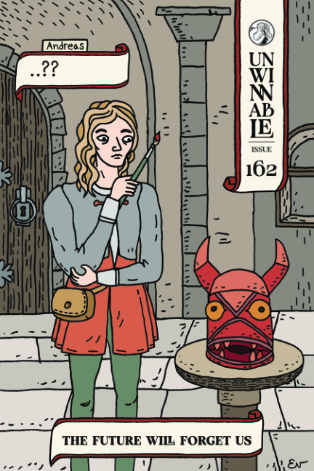
Videogames and the Global Haunted House

This column is a reprint from Unwinnable Monthly #162. If you like what you see, grab the magazine for less than ten dollars, or subscribe and get all future magazines for half price.
———
We are what we’re afraid of.
———
On April 15, 2012, a free-to-play survival horror game called SCP: Containment Breach became available on the internet. In this game, you wander the halls of a laboratory-esque facility that you discover was built to house supernatural creatures of varying levels of aggression and power. As the title suggests, these creatures have escaped their confinement and are now wandering the facility along with you, and your goal is simply to survive.
Independent of anything else, this game is a fun and fairly scary time: I remember playing it with friends in my freshman dorm room shortly after release and being scared witless by a couple of the creatures. The game truly becomes critically and societally interesting, however, when you examine its origins: as a creation that arose in response to the SCP Foundation, a fan-created and -curated horror fiction website. On this website, which is styled as the internal record-keeping and scientific documentation of the fictional monster-catching organization, any person can write an entry and submit it to the archive. Entries are voted on and curated by members of the community, with entries rising to the front page with the popular vote or being marked as being explicitly sub-par (but retained on the site for transparency and democratic values, ostensibly). The videogame arose as a work of fanfiction . . . about things already generated by fans.
This is cool and interesting to me particularly as a scholar whose day job is examining digital media, but it’s cool and interesting generally because the existence of this game says things about how we interact with each other on the internet. The very way the SCP Foundation website is structured relies on user participation, not just as consumers of media but as active creators (i.e., making new entries that continue the story and meet the generic and tonal conventions of the story) and also active curators (policing entries for cohesion with the established canon of works). Fans are thus in control of the canon of the SCP in ways they generally aren’t in other forms of media, and further, taking an active role in curation of the canon is of positive benefit to the community by sifting out new quality content, rather than being irritating and gatekeeping, as we often associate with curation of fandom.
In digital media studies, we refer to things like this as “participatory culture” – it’s an idea spawned by media theorist Henry Jenkins, who claims that the immediate audience response allowed by the internet has fundamentally changed the way communities arise around texts and fandoms. And while sometimes this can definitely be leveraged for evil (I’m thinking here of all the fan petitions to change the ending of this or that piece of media), it’s also really cool and positive for people who belong to smaller or niche fan communities, like the SCP and horror more generally. While we can never get rid of gatekeeping neckbeards entirely, try though we might, what this idea of “participatory culture” does is to inherently democratize the marketplace of media ideas. You no longer need to have an agent, a signed deal and a production team several dozen people strong to make a piece of media (though it doesn’t hurt); the internet is now a place where creations such as SCP Containment Breach can exist because of the cumulative creative and intellectual work of an entire community of people. The SCP Foundation represents the idea that horror is better together; not just in its reception, but also in its creation.
I’ve personally drawn from the SCP archive in my own gaming – as a GM of a group of players gathered around the tabletop RPG Monster of the Week, I created a story based in the SCP universe, where the players were low-level operatives of the Foundation. Each week, they faced off against a different creature who I’d pull from the archive and build into the game using the mechanics of the system. While the creatures were not my individually created IP, my fan-work with the archive created a new and interesting series of documents that contributed to how I and my players understood the SCP universe. Without this experience of play, I think my appreciation of the creative work of the entry-writers would be flatter, less nuanced.
All this to say, horror – whether it’s games, films, or creepypastas – is a collaborative, communal endeavor that’s just fundamentally better when we try to pull new and creative things out of the scary worlds we’re flung into. While I’m not suggesting you aren’t a true horror fan if you aren’t writing Pyramid Head fanfiction, I am suggesting that, if you have the creative itch, the online horror and horror games community is an excellent place to scratch.
———
Emma Kostopolus loves all things that go bump in the night. When not playing scary games, you can find her in the kitchen, scientifically perfecting the recipe for fudge brownies. She has an Instagram where she logs the food and art she makes, along with her many cats.




